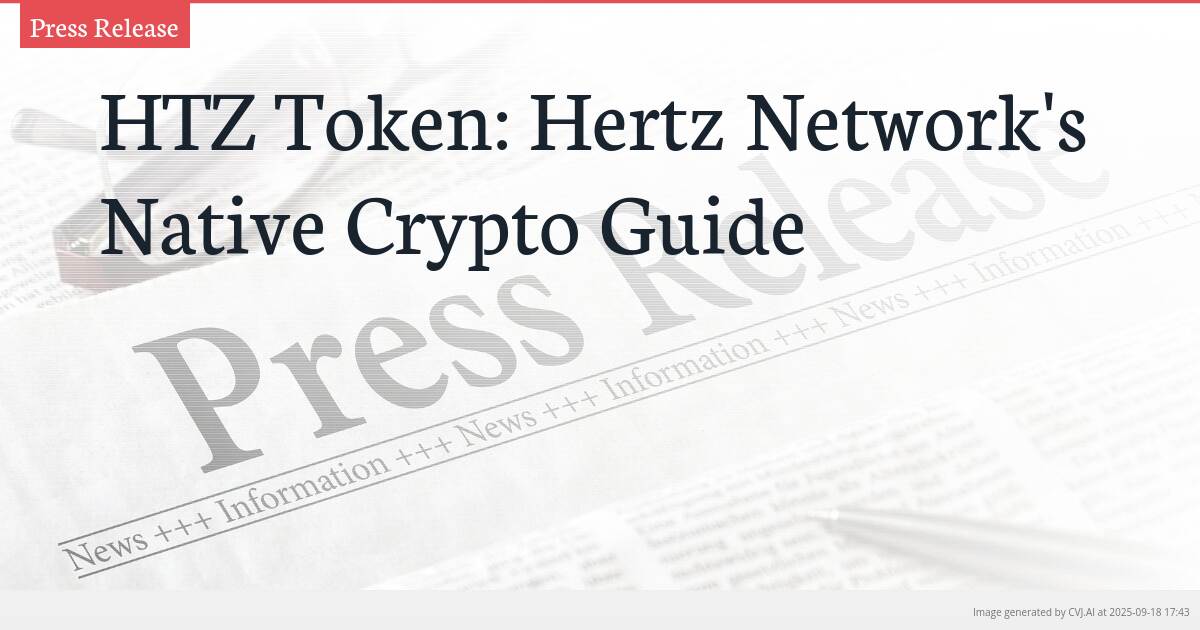This summary text is fully AI-generated and may therefore contain errors or be incomplete.
Introduction
The HTZ token serves as the native currency for the Hertz Network, a feeless DeFi blockchain powered by EOSIO. This guide covers where and how to acquire HTZ, its tokenomics, and its role within the ecosystem.
Key Points
- Hertz Network enables instant creation of customizable HNC-20 tokens, requiring 10,000 HTZ in wallet for token generation.
- HTZ exists in three interoperable formats: native coin, ERC-20 (Ethereum), and BEP-20 (Binance Smart Chain), all swappable 1:1.
- The token supply is 29.1 billion, with 30% dedicated to development and individual funds, and the rest auto-staked.
Understanding the Hertz Network and HTZ Token
The Hertz Network is a feeless decentralized finance (DeFi) blockchain built on EOSIO technology, designed to facilitate instant creation and exchange of custom tokens. At its core is the HTZ token, the native cryptocurrency that powers all operations within the network. HTZ functions not only as a medium of exchange but also as a requisite for generating new tokens, requiring users to hold 10,000 HTZ in their wallet to create customizable HNC-20 tokens via the network’s token creation tool.
HTZ exists in three interoperable formats to enhance accessibility and utility across different blockchain ecosystems. The native HTZ coin operates directly on the Hertz Network, while HTZ ERC-20 and HTZ BEP-20 tokens represent the asset on the Ethereum and Binance Smart Chain networks, respectively. These variants are swappable at a 1:1 ratio through the Hertz Network’s DeFi tools or on supported exchanges, ensuring seamless cross-chain functionality and compatibility with popular wallets like Trust Wallet, MetaMask, and MyEtherWallet.
Tokenomics and Supply Distribution
As of December 2021, the total supply of HTZ tokens stands at 29.1 billion. The allocation of this supply is strategically divided to support the network’s growth and sustainability. Thirty percent is earmarked for development and individual funds, providing resources for ongoing innovation and ecosystem expansion. The remaining seventy percent is designated for auto-staking, a mechanism that incentivizes long-term holding and participation in the network’s security and governance.
This economic model emphasizes both utility and investment potential, with auto-staking promoting token retention and stability. The fixed supply cap and structured distribution aim to balance liquidity with value appreciation, positioning HTZ as a foundational asset within the Hertz Network’s DeFi landscape.
Acquiring and Trading HTZ Tokens
HTZ tokens are accessible through multiple centralized and decentralized exchanges, enhancing their liquidity and ease of acquisition. Major platforms include XT.com, Binance, 1inch, and Uniswap, where users can trade HTZ in its various forms—native, ERC-20, or BEP-20. Transactions incur nominal fees, making it cost-effective for both retail and institutional traders.
To purchase HTZ, users cannot use fiat currency directly; instead, they must first acquire USDT (Tether), a stablecoin widely used in crypto trading. With USDT in a compatible wallet such as MetaMask, traders can swap for HTZ on supported exchanges. For instance, on XT.com, the process involves logging into an account, navigating to the trading pair (e.g., HTZ/USDT), and executing the swap. Similar steps apply on other platforms, ensuring a straightforward entry into the HTZ ecosystem.
The interoperability of HTZ across Ethereum and Binance Smart Chain, coupled with its availability on diverse exchanges, underscores its versatility and growing adoption. As the Hertz Network continues to evolve, HTZ remains a pivotal asset for developers, traders, and DeFi enthusiasts seeking exposure to innovative blockchain solutions.
📎 Read the original article on coincodecap.com

